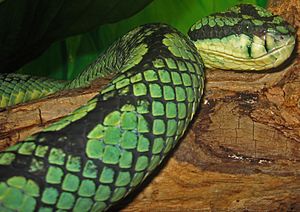Sri Lankan pit viper facts for kids
Quick facts for kids Trimeresurus trigonocephalus |
|
|---|---|
 |
|
| Scientific classification | |
| Kingdom: | |
| Phylum: | |
| Subphylum: | |
| Class: | |
| Order: | |
| Suborder: | |
| Family: | |
| Subfamily: | |
| Genus: |
Trimeresurus
|
| Species: |
T. trigonocephalus
|
| Binomial name | |
| Trimeresurus trigonocephalus (Donndorff, 1798)
|
|
The Trimeresurus trigonocephalus, often called the Sri Lankan Green Pit Viper, is a type of venomous snake. It belongs to the pit viper family. You can find this snake only in Sri Lanka. There are no different types (subspecies) of this snake known today.
Contents
What Does It Look Like?
This snake is mostly green. Its back might have some yellow colors. It also has black stripes and a black tail.
Female Sri Lankan Green Pit Vipers are bigger than males. Females can grow to about 130 centimeters (about 51 inches) long. Males are smaller, growing up to 80 centimeters (about 31 inches).
How Does It Live?
The Sri Lankan Green Pit Viper is a nocturnal animal. This means it is active mostly at night. It is also arboreal, which means it lives in trees.
Sometimes, it comes down to the ground. It looks for food there. It eats frogs, lizards, and small mammals. It also finds and eats birds in the trees. In the morning, these snakes often rest on tree branches. They warm up their bodies using the sun's rays.
Reproduction
The Sri Lankan Green Pit Viper is viviparous. This means the mother snake gives birth to live young. They do not lay eggs.
They usually have their babies in June and July. A mother snake can give birth to between 5 and 25 young snakes at one time.
Where Does It Live?
These snakes live in Sri Lanka. They can be found in grasslands and rain forest areas.
What Are Its Other Names?
Besides the Sri Lankan Green Pit Viper, this snake has other common names. People also call it the "Pala Polonga" or simply the "Green Pit Viper".
About Its Venom
The venom of the Sri Lankan Green Pit Viper is hemotoxic. This means it affects the blood and tissues.
If someone is bitten by this snake, the bite area becomes very painful. It also swells up. The pain can last for several days. The bite can cause cells in the tissue to die. It can also cause blisters. Other effects include a drooping eyelid (called ptosis) and swollen lymph nodes (called lymphadenopathy). However, there have been no reports of people dying from a bite from this snake.
Images for kids
See also
 In Spanish: Trimeresurus trigonocephalus para niños
In Spanish: Trimeresurus trigonocephalus para niños


